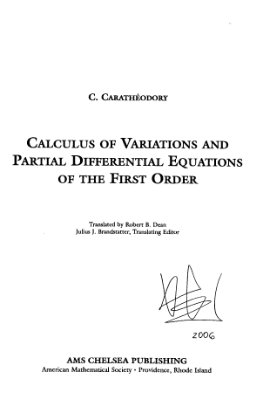American Mathematical Society, 1999. - 402 pages.
In this second English edition of Carath?odory's famous work (originally published in German), the two volumes of the first edition have been combined into one (with a combination of the two indexes into a single index). There is a deep and fundamental relationship between the differential equations that occur in the calculus of variations and partial differential equations of the first order: in particular, to each such partial differential equation there correspond variational problems. This basic fact forms the rationale for Carath?odory's masterpiece. Includes a Guide to the Literature and an Index.
From the Preface: "The book consists of two parts. In the first part, I have made an attempt to simplify the presentation of the theory of partial differential equations to the first order so that its study will require little time and also be accessible to the average student of mathematics . The second part, which contains the Calculus of Variations, can also be read independently if one refers back to earlier sections in Part I . I have never lost sight of the fact that the Calculus of Variations, as it is presented in Part II, should above all be a servant of Mechanics. Therefore, I have in particular prepared everything from the very outset for treatment in multidimensional spaces. "
In this second English edition of Carath?odory's famous work (originally published in German), the two volumes of the first edition have been combined into one (with a combination of the two indexes into a single index). There is a deep and fundamental relationship between the differential equations that occur in the calculus of variations and partial differential equations of the first order: in particular, to each such partial differential equation there correspond variational problems. This basic fact forms the rationale for Carath?odory's masterpiece. Includes a Guide to the Literature and an Index.
From the Preface: "The book consists of two parts. In the first part, I have made an attempt to simplify the presentation of the theory of partial differential equations to the first order so that its study will require little time and also be accessible to the average student of mathematics . The second part, which contains the Calculus of Variations, can also be read independently if one refers back to earlier sections in Part I . I have never lost sight of the fact that the Calculus of Variations, as it is presented in Part II, should above all be a servant of Mechanics. Therefore, I have in particular prepared everything from the very outset for treatment in multidimensional spaces. "

